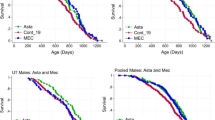Abstract
Recent studies have shown that tetrafluoroethylene is a renal and hepatic carcinogen in the rat. In this study, we have examined the ability of a single i.p. dose of 1,1,2,2-tetrafluoroethyl-l-cysteine (TFEC), a major metabolite of tetrafluoroethylene, to produce hepatic and renal injury in male and female rats. We have also examined the effect of blocking the renal organic anion transport system with probenecid and of inhibiting the activity of cysteine conjugate β-lyase with aminooxyacetic acid on the extent of renal injury produced by TFEC. Doses of ≥12.5 mg/kg TFEC produced renal tubular necrosis to the pars recta of the proximal tubules within 24 h in both male and female rats. This was associated with an increased kidney to body weight ratio and plasma urea at doses of ≥25 mg/kg. No consistent evidence of liver injury was seen at doses up to 50 mg/kg TFEC in rats of either sex, although occasional vacuolation of hepatocytes and a small dose-related increase in liver to body weight ratio was observed. Prior treatment of female rats with probenecid completely prevented the renal injury produced by either 25 or 50 mg/kg TFEC as judged by plasma urea and histopathology. However, prior treatment of female rats with aminooxyacetic acid afforded no protection against the nephrotoxicity produced by either TFEC or the cysteine conjugate of hexachloro-1,3-butadiene. Thus no major sex difference in nephrotoxicity in the rat was seen with TFEC, while accumulation of TFEC, or its N-acetyl derived metabolite, into renal proximal tubular cells via a probenecid sensitive transport system appears to be a key event in the mechanism of nephrotoxicity. The lack of protection observed with the cysteine conjugate β-lyase inhibitor, aminooxyacetic acid, may reflect the inability to completely inhibit the mitochondrial form of this enzyme and thereby prevent the formation of the reactive metabolite. Our acute studies provide no insight concerning the liver carcinogenicity of tetrafluoroethylene.
Similar content being viewed by others
Author information
Authors and Affiliations
Additional information
Received: 8 December 1997 / Accepted: 3 February 1998
Rights and permissions
About this article
Cite this article
Lock, E., Ishmael, J. The nephrotoxicity and hepatotoxicity of 1,1,2,2-tetrafluoroethyl-L-cysteine in the rat. Arch Toxicol 72, 347–354 (1998). https://doi.org/10.1007/s002040050513
Issue Date:
DOI: https://doi.org/10.1007/s002040050513




